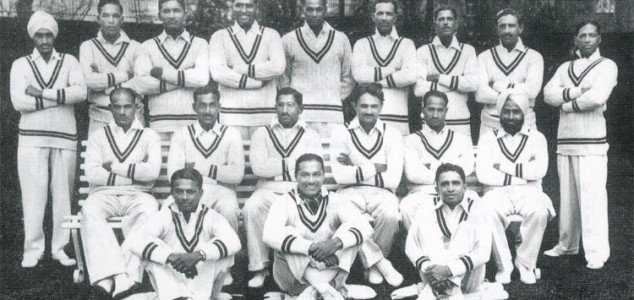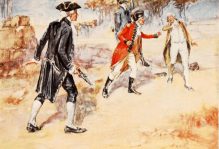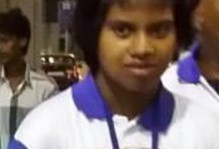
India’s Lagaan Moment: First Indian Test Cricket Team
The Indian Test Cricket team which played India’s first Test match. The match was played at Lords against the full strength English Test side at Lords in 1932. Standing (from right): Lal Singh, Phiroze Palia,Jahangir Khan, Mohammad Nissar, Amar Singh, Bahadur Kapadia, Shankarrao Godambe, Ghulam Mohammad, JanardanNavle. Seated (from right): Syed Wazir Ali, C.K.Nayudu, Maharaja of Porbandar (captain), KS Limbdi (vice‐captain), Nazir Ali, Joginder Singh. Front (from right) : Naoomal Jaoomal, Sorabji Colah, Nariman Marshall.
Bhuvan was captain CK Naidu,Bhura was the paceman Mohammad Nissar, Ishwar was the wicketkeeper Janardhan Navle, Deva the all‐rounder Amar Singh.The dusty grounds of Champaner,in this case was the historic cricket field at Lords ,and the Lagaan moment was India’s first ever test match against the full strength English national team in the summer of 1932. While in the film Lagaan the Indian team won, at Lords on the fateful day of 28 June 1932 India lost. However the team had acquitted itself with pride having given the experienced English side some very scary moments. It was not a washout; it was a match between equals.
The journey of the Indian team to play its first ever test match actually started about more than 200 years back when cricket came to Indian shores imported from England by the British traders and soldiers. The first mention of a cricket match played in India was by British sailors in Cambay in 1721. The Parsis’ were the first Indian community to take interest in cricket. They established the Oriental Cricket Club in 1846 and subsequently the Parsi Cricket Club. The Hindus and the Muslims later picked up the game and formed their own clubs. It was the
Parsi Cricket Club which sent the first team overseas in 1886 about 130 years ago. A team of 15 enthusiastic Parsis, each player
funding his own travel, landed on English shores to play cricket. Much was not expected from the team‐ it played in 28 matches, lost
19, drew 8 and won only 1. DH Patel, the Captain of the Parsi Club team on return home said “It was not with any object of gaining
victories that we made the voyage to England, but we decided to pay homage to the centre and home of a noble game, and we desired to learn some useful lessons in its play”. A statement which reflects both humility and resolve‐ the necessary ingredients for success.
The second Indian cricket team to visit overseas was again the Parsi Cricket Club team in the year 1888 lead by Pestonji D Kanga to England. This team acquitted itself much better‐31 matches, 11 losses, 12 draws and 8 wins. The legendary English cricketer W.G. Grace commented “In one thing they showed excellent promise, their consistent effort in playing an uphill match.”
It took 23 years (1911) before an Indian Team of truly national character would go on an overseas tour. In true sense the 1911 team was the first national Indian Cricket team. The team was captained by Maharaja of Patiala, not primarily because of his cricketing credentials
but more for his royal lineage. The 1911 team did not do very well – it played 14 first‐class matches, won 2, drew 2 and lost 10. While the result is imminently forgettable, the team made a statement which is worth remembering and celebrating. In this team were two
brothers Baloo Palwankar and Shivram Palwankar, untouchables by caste. The presence of players from untouchable caste in a team
with majority upper caste Hindu members and captained by a royal was revolutionary for the early twentieth century India. By
selecting the Palwankar brothers, the selectors made the statement‐ that ability and not caste which mattered on the cricket field. Baloo
justified his selection – this slow left‐arm spinner took 75 wickets at 20.12 with a best analysis of 8‐103. He received several offers to stay in England and play as a professional. He choose to come home. What is surprising is that Baloo had learnt his cricket by occasionally bowling at the nets of a cricket club where he was paid to sweep and roll the pitch. Baloo was felicitated on his return home and one of the organisers of the event was a young man named BR Ambedkar. Do we see strains of Kacchra from the film Lagaan in the achievement of Baloo Palwankar?
Cricket was getting popular in India, there was a domestic league, Indian teams had undertaken three foreign tours and there were a bunch of promising Indian players. However India was still considered babe in the woods as far as cricket was concerned and not accorded Test status, for it had yet to prove its mettle against crack English teams. The opportunity came when Marylebone Cricket Club (MCC) team visited India in 1926‐27 under the stewardship of test player and English captain Arthur Gilligan. The MCC team was to play local Indian teams and showcase English skills at cricket. The match which made the English sit up and take Indian cricket seriously was one played between the Hindu club and the MCC at Bombay Gymkhana. CK Naidu hit 153 with 11 sixes. This was made against the fearsome pace attack of Maurice Tate, George Geary and Bob Wyatt. The MCC presented Naidu with a silver bat in acknowledgement of that innings. Cricket historians believe that it was this particular knock that impressed Gilligan who carried the message to the authorities in England that India was ready to play Test cricket.
June 25, 1932 was a historic moment for Indian cricket‐ India was to play its first cricket test match against the full strength English team at the Lords cricket ground. The Indian captain Maharaja of Porbander sat out of the match‐ a gesture which needs to be acknowledged, for the Maharaja was not the best cricketer amongst 18 member team, the mantle of captainship he handed to CK Naidu unquestionably the most experienced in the team.
Battle Ready‐ The final eleven of the Indian team which took the battle to the English Camp. Seen here on the Lords ground before the start of the first test match. Photo Courtesy : Outlook
Mohammad Nissar bowled India’s first ball in Test Cricket. Facing him was the world’s best opening batsman of that time Herbert Sutcliffe. Sutcliff’s career batting average at 60.73 is the highest by any English batsman and the sixth‐ highest worldwide. At the non striker’s end stood Percy Holmes, who along with Sutcliffe held the then world record of highest opening partnership of 555 runs in first class cricket. The Indian bowling attack was facing the world’s best opening batting pair. Even to the most patriotic Indian supporter sitting in the stadium filled with 25000 spectators the contest seemed a bit unfair. Both Nissar and his opening bowling partner Amar Singh purchased fiery pace of the wicket. Captain CK Naidu put pressure placing three slips and two short legs, reputation of the batsmen notwithstanding. Indians did not seem to be the underdogs.
With English score at 8 runs,Sutcliffe played a vicious in‐swinging yorker from Nissar on to his leg stump. Three runs later, the bowler brought one back at lightning pace to send the off stump of Holmes flying. The famed English opening pair was back in pavilion with score reading merely 9/2.The unknown Indian side was no penny pusher.
Coming at number three was the immensely experienced Frank Woolley later to find place in ICC Cricket hall of Fame. A misjudgement while taking the second run saw the agile Lal Singh run Woolley out with an accurate throw. Within twenty minutes of start the English were tottering at 19/3. The English had not bargained for this, the English dressing room went into a huddle. The situation was alarming. Wally Hammond and English captain Douglas Jardine dug and negotiated the fearsome pace attack with patience and skill. It was not easy at the pitch with Nissar, Amar Singh, Jehangir Khan and Naidu bowling their heart out. The two batsmen piled up 82 for the fourth wicket till Amar Singh breached Hammond’s defences and clean bowled him. The English were still not out of the woods the score stood at 101/4. And soon to depart was Eddie Paynter another of the world’s top batsmen in English team ranks reducing England to 149/5.
It was then that the Indian concentration faltered, wicket keeper Navle missed a stumping of the next batsman Les Ames even before the batsman had scored. This proved costly; Ames went on to make 65 runs.Had the stumping happened England score would have read 149/6 and exposed its tail enders.Not a happy situation at all.England was all out for 259, with captain Jardine the top scorer with 79. Mohammad Nissar bagged 5 wickets.
Indians openers Naoomal Jaoomal and Janardan Navle walked in to start the Indian innings under fading lights on the first day. They negotiated the new ball well and at draw of stumps the Indian innings stood at 30/0. Clearly the first day had gone India’s way; it was India’s Lagaan moment. The Indian spirited performance continued till lunch on the second day when India was 101/2, with two of its best batsmen, CK Naidu and Wazir Ali at the crease. Post lunch the English fast bowling machine comprising of Voce and Bowes fired and Indian’s lack of batting depth was exposed. The Indian middle order collapsed like a house of cards and Indians were all out for 189 giving English a lead of 70 runs.
The English second innings saw the demolition squad lead by Jehangir Khan and Amar Singh reduce the English score to 67 / 4. As in the first innings, Jardine got going and along with Paynter and assisted by some hard hitting by Robbins and Brown took the score to 275 and declared the innings leaving the Indian batsman with a target of 346, indeed a tall order.
Indian batting could not live up to the challenge, only Amar Singh, coming in at 108/7, sparkled for a while, hitting Robins for 19 in an over, including a six – adding 74 in 45 minutes with Lal Singh. His 51 took India to 187, the final margin of loss being a comprehensive 158. It is true that while Indian bowling and fielding was world class, the Indian batting left much to be desired. Unfortunately for India, two of her best batsmen ‐ Nawab of Pataudi and Duleepsinghji of Jamnagar, both of whom earned place in the English national team, refused to play for the All India Cricket team of 1932. Had these two batsmen been playing, India might well have defeated England in its maiden Test encounter and that match would have become part of the Indian cricketing lore.
Interestingly during the 1932 tour when the All India Team played its first class match against the Sussex County, there were two Indian captains on the field ‐ CK Naidu the All India Team Captain and Duleepsinghji the Sussex team captain. Another player who was missed dearly at Lords was DN Deodhar (afterwhom the Deodhar Trophy is named). In 1932 at the age of 40 he was considered too old for the team. Deodhar was a prolific batsman with a first class average of 40. On hindsight, age factor probably got a bit 0verplayed, Deodhar led Maharashtra to their only two Ranji Trophy triumphs in 1939‐40 and 40‐41, eight years after the first Test at Lords was played.
SJ Southerton writing for Wisden expressed “The tour proved of immense value to the Indians ……, and the lessons they learned will no doubt be passed on to the Indian cricketers of the future”. The lessons were surely passed on, and when players likeVirat Kohli or Mahender Singh Dhoni take stance , the legacy of those lessons is visible in practice, passed on through generations of Indian cricketers.






Excellent article. I certainly love this website. Stick with it!